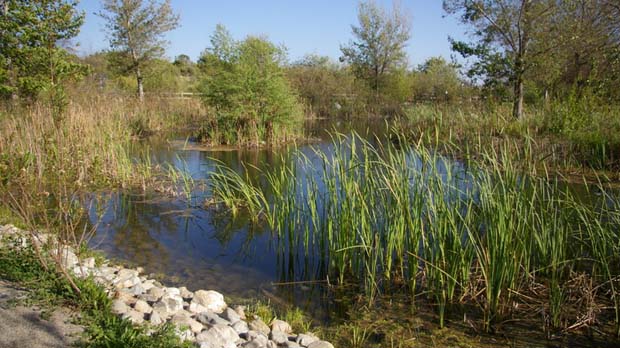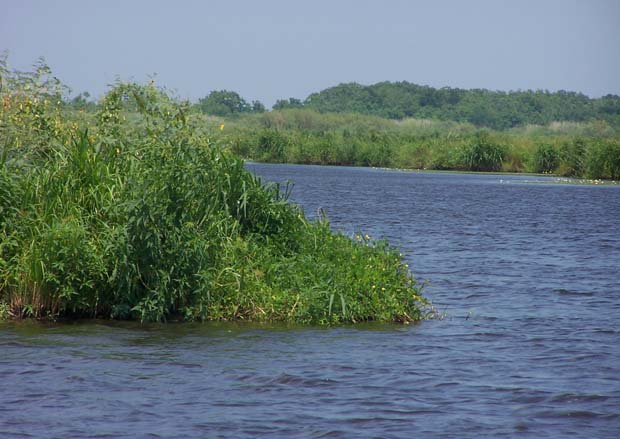EVERY HOUR AN ACRE OF LOUISIANA SINKS INTO THE SEA. WHO IS TO BLAME?
By Nataniel Rich / New York Times Magazine / October 5, 2014
[dropcap]I[/dropcap]n Louisiana, the most common way to visualize the state’s existential crisis is through the metaphor of football fields. The formulation, repeated in nearly every local newspaper article about the subject, goes like this: Each hour, Louisiana loses about a football field’s worth of land. Each day, the state loses nearly the accumulated acreage of every football stadium in the N.F.L. Were this rate of land loss applied to New York, Central Park would disappear in a month. Manhattan would vanish within a year and a half. The last of Brooklyn would dissolve four years later. New Yorkers would notice this kind of land loss. The world would notice this kind of land loss. But the hemorrhaging of Louisiana’s coastal wetlands has gone largely unremarked upon beyond state borders. This is surprising, because the wetlands, apart from their unique ecological significance and astounding beauty, buffer the impact of hurricanes that threaten not just New Orleans but also the port of South Louisiana, the nation’s largest; just under 10 percent of the country’s oil reserves; a quarter of its natural-gas supply; a fifth of its oil-refining capacity; and the gateway to its internal waterway system. The attenuation of Louisiana, like any environmental disaster carried beyond a certain point, is a national-security threat.
Where does it go, this vanishing land? It sinks into the sea. The Gulf of Mexico is encroaching northward, while the marshes are deteriorating from within, starved by a lack of river sediment and poisoned by seawater. Since 2011, the National Oceanic and Atmospheric Administration has delisted more than 30 place names from Plaquemines Parish alone. English Bay, Bay Jacquin, Cyprien Bay, Skipjack Bay and Bay Crapaud have merged like soap bubbles into a single amorphous body of water. The lowest section of the Mississippi River Delta looks like a maple leaf that has been devoured down to its veins by insects. The sea is rising along the southeast coast of Louisiana faster than it is anywhere else in the world.
The land loss is swiftly reversing the process by which the state was built. As the Mississippi shifted its course over the millenniums, spraying like a loose garden hose, it deposited sand and silt in a wide arc. This sediment first settled into marsh and later thickened into solid land. But what took 7,000 years to create has been nearly destroyed in the last 85. Dams built on the tributaries of the Mississippi, as far north as Montana, have reduced the sediment load by half. Levees penned the river in place, preventing the floods that are necessary to disperse sediment across the delta. The dredging of two major shipping routes, the Mississippi River Gulf Outlet and the Gulf Intracoastal Waterway, invited saltwater into the wetlands’ atrophied heart.
Beneath the surface, the oil and gas industry has carved more than 50,000 wells since the 1920s, creating pockets of air in the marsh that accelerate the land’s subsidence. The industry has also incised 10,000 linear miles of pipelines, which connect the wells to processing facilities; and canals, which allow ships to enter the marsh from the sea. Over time, as seawater eats away at the roots of the adjacent marsh, the canals expand. By its own estimate, the oil and gas industry concedes that it has caused 36 percent of all wetlands loss in southeastern Louisiana. (The Interior Department has placed the industry’s liability as low as 15 percent and as high as 59 percent.) A better analogy than disappearing football fields has been proposed by the historian John M. Barry, who has lived in the French Quarter on and off since 1972. Barry likens the marsh to a block of ice. The reduction of sediment in the Mississippi, the construction of levees and the oil and gas wells “created a situation akin to taking the block of ice out of the freezer, so it begins to melt.” Dredging canals and pipelines “is akin to stabbing that block of ice with an ice pick.”
The oil and gas industry has extracted about $470 billion in natural resources from the state in the last two decades, with the tacit blessing of the federal and state governments and without significant opposition from environmental groups. Oil and gas is, after all, Louisiana’s leading industry, responsible for around a billion dollars in annual tax revenue. Last year, industry executives had reason to be surprised, then, when they were asked to pay damages. The request came in the form of the most ambitious, wide-ranging environmental lawsuit in the history of the United States. And it was served by the most unlikely of antagonists, a former college-football coach, competitive weight lifter and author of dense, intellectually robust 500-page books of American

Reasearch shows wetlands loss in Louisiana has the following signature – every 2.5 miles of wetlands lost, storm surges rise by one foot.
‘When Hurricane Katrina made landfall in Louisiana on Aug. 29, 2005, John Barry was a year and a half into writing his sixth book, “Roger Williams and the Creation of the American Soul,” about the puritan theologian’s efforts to define the limits of political power. Barry is not a fast writer; his books take him, on average, eight years to complete. “I tend,” Barry says, “to obsess.” Earlier in his career, he spent nearly a decade as a political journalist, writing about Congress, an experience he drew upon for his first book, “The Ambition and the Power.” But after that book’s publication, he quit journalism and cocooned himself in research, reading and writing. He took on vast, complex episodes in American history that in his rendering become Jacobean dramas about tectonic struggles for power. “The Ambition and the Power” would make an appropriate subtitle for any of his books — particularly “Rising Tide,” his history of the 1927 Mississippi River flood, the most destructive in American history.
Barry’s research for “Rising Tide” had made him an amateur expert on flood prevention, and in the days after Hurricane Katrina, he received requests from editors and television-news producers for interviews. He accepted nearly every one of them and within days of the storm had become one of the city’s most visible ambassadors in the national press. “I felt I had an obligation,” Barry told me, “to convince people that the city was worth rebuilding.”
Like many others, Barry was frustrated that he couldn’t figure out why New Orleans had flooded so catastrophically. When he studied the numbers — the wind shear on Lake Pontchartrain, the storm surge, the inches of rainfall — they didn’t add up. After making calls to some of his old sources, he concluded that the levees hadn’t been overtopped, as officials from the Army Corps of Engineers assumed, but had collapsed because of design flaws. (He was among the first to draw attention to this fact in an Op-Ed article published in The New York Times that October.) Barry concluded that just as in 1927, people died because of cynical decisions made by shortsighted politicians drawing on bad science. For Barry, Hurricane Katrina was not the story of a natural disaster; it was a story of politics, science and power.
It seemed like the ideal basis for a John Barry book, but Barry decided not to write a book. Instead, on the cusp of his 60th birthday in 2006, he entered public life. He wrote editorials for The Times, The Los Angeles Times, The Washington Post and USA Today. He joined state committees charged with improving flood control. He called a friend in Congress who sat on the Appropriations Committee and met with other lawmakers and their staffs. He toured flood-management systems in the Netherlands. He began to resemble Andrew Humphreys, a conflicted hero of “Rising Tide,” who arrived in New Orleans in 1850 to study flood control: “The work obsessed him, unbalanced him, pushed him to the margin. He stopped writing . . . because it distracted him. . . . He himself talked to reporters. He basked in their attention, basked in their portrayal of him as a major figure.”

Louisiana is reponsible for about 17% of all U. S. oil refining and supports thousands of jobs, but share the blame, along with others, for the destruction of the states wetlands. Photo credit LA Times.
In Washington, where Barry lives for part of the year, he met with a freshman representative from the state’s First Congressional District, which includes much of southeastern Louisiana: Bobby Jindal. He begged Jindal to demand action from the White House. New Orleans couldn’t count on its mayor, or on the governor, he said; the city needed a hero on Capitol Hill. After speaking for two hours, Barry recalled, Jindal said that taking a leadership position on Hurricane Katrina “didn’t fit his timing for running for governor.” (Jindal, who declined to comment for this article, was elected governor in 2007.) “I left in total disgust,” Barry said.
Barry has a special talent for disgust. His face at rest conveys a pained forbearance. A lifetime spent studying the behavior of powerful people motivated by low ambitions has made him quick to skepticism. He is a master of winces, grimaces and exasperated smiles. His voice is gravelly and low, though indignation amplifies it fivefold. At 67, Barry is 5-foot-9 and powerfully built — he participated in national weight-lifting competitions as recently as 1998. He played football at Brown and, after dropping out of a Ph.D. history program, joined Tulane University’s football team as a receivers’ coach. In his office in downtown New Orleans, the most prominent wall decoration is a laminated Times-Picayune newspaper from 1973 that celebrates the first Tulane victory over Louisiana State in 25 years. When discussing his public battles, he often summons football metaphors. “Writing is pretty isolated,” he said. “I enjoy the action. I like to fight.”
In the miasma of incompetence after Hurricane Katrina, Barry’s intellectual gravity and combativeness elevated him rapidly in the public trust. When the Louisiana Legislature created a regional levee board, Barry was urged by several local leaders to apply for a seat. The board — the Southeast Louisiana Flood Protection Authority-East, or Slfpa-E — would be responsible for overseeing all flood-management projects in its jurisdiction, which includes nearly all of New Orleans. Because the continued existence of the city depends on its ability to manage floods, this was no small responsibility. Some of the nation’s leading experts on flood protection were appointed to the board, among them California’s flood-plain-management chief, a former president of the American Society of Civil Engineers and the marine scientist responsible for one of the first efforts, in the late ‘80s, to restore coastal Louisiana. Barry was appointed in 2007 and functioned as the board’s spokesman.
to read complete story, click here . . .








